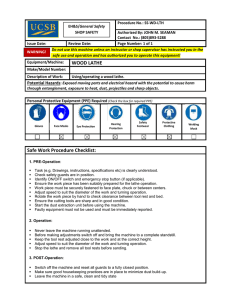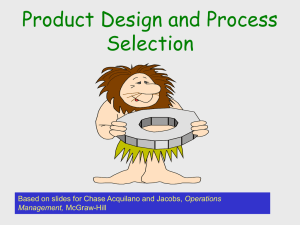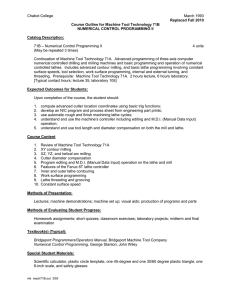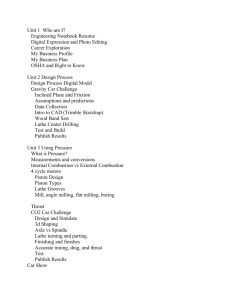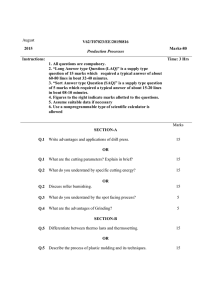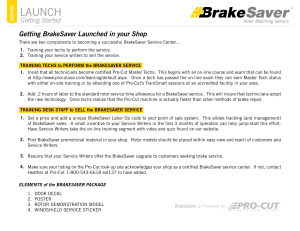IRJET-Alteration of Lathe Machine into Splitting Machine
advertisement
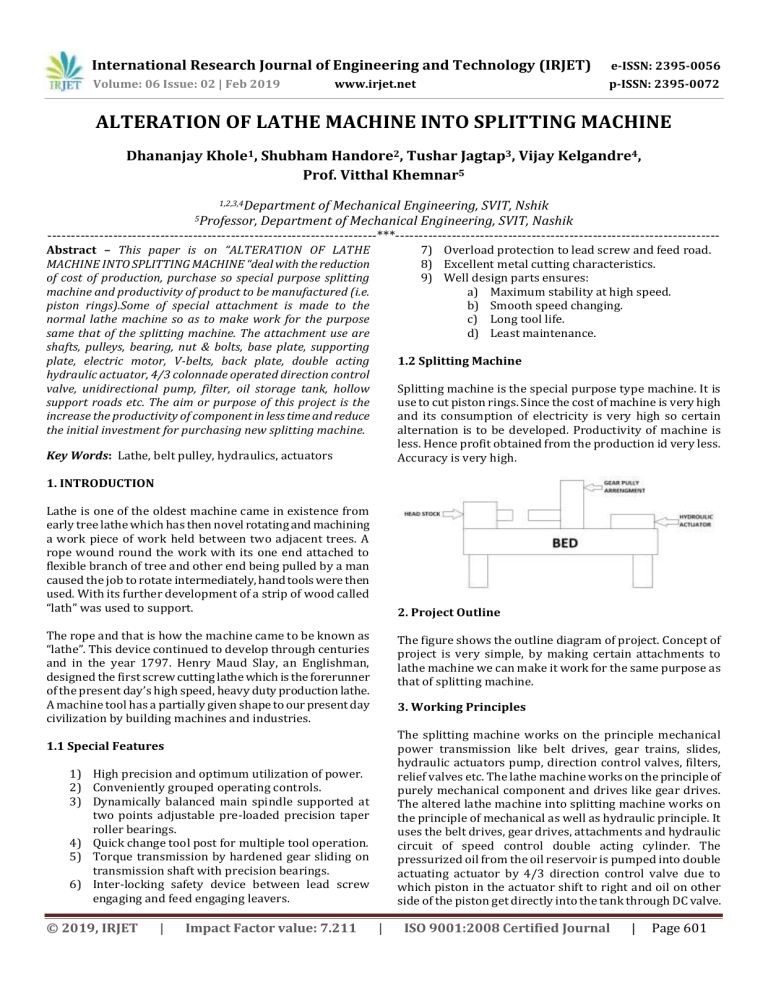
International Research Journal of Engineering and Technology (IRJET) e-ISSN: 2395-0056 Volume: 06 Issue: 02 | Feb 2019 p-ISSN: 2395-0072 www.irjet.net ALTERATION OF LATHE MACHINE INTO SPLITTING MACHINE Dhananjay Khole1, Shubham Handore2, Tushar Jagtap3, Vijay Kelgandre4, Prof. Vitthal Khemnar5 1,2,3,4Department of Mechanical Engineering, SVIT, Nshik Department of Mechanical Engineering, SVIT, Nashik ----------------------------------------------------------------------***--------------------------------------------------------------------5Professor, Abstract – This paper is on “ALTERATION OF LATHE MACHINE INTO SPLITTING MACHINE “deal with the reduction of cost of production, purchase so special purpose splitting machine and productivity of product to be manufactured (i.e. piston rings).Some of special attachment is made to the normal lathe machine so as to make work for the purpose same that of the splitting machine. The attachment use are shafts, pulleys, bearing, nut & bolts, base plate, supporting plate, electric motor, V-belts, back plate, double acting hydraulic actuator, 4/3 colonnade operated direction control valve, unidirectional pump, filter, oil storage tank, hollow support roads etc. The aim or purpose of this project is the increase the productivity of component in less time and reduce the initial investment for purchasing new splitting machine. 7) Overload protection to lead screw and feed road. 8) Excellent metal cutting characteristics. 9) Well design parts ensures: a) Maximum stability at high speed. b) Smooth speed changing. c) Long tool life. d) Least maintenance. 1.2 Splitting Machine Splitting machine is the special purpose type machine. It is use to cut piston rings. Since the cost of machine is very high and its consumption of electricity is very high so certain alternation is to be developed. Productivity of machine is less. Hence profit obtained from the production id very less. Accuracy is very high. Key Words: Lathe, belt pulley, hydraulics, actuators 1. INTRODUCTION Lathe is one of the oldest machine came in existence from early tree lathe which has then novel rotating and machining a work piece of work held between two adjacent trees. A rope wound round the work with its one end attached to flexible branch of tree and other end being pulled by a man caused the job to rotate intermediately, hand tools were then used. With its further development of a strip of wood called “lath” was used to support. 2. Project Outline The rope and that is how the machine came to be known as “lathe”. This device continued to develop through centuries and in the year 1797. Henry Maud Slay, an Englishman, designed the first screw cutting lathe which is the forerunner of the present day’s high speed, heavy duty production lathe. A machine tool has a partially given shape to our present day civilization by building machines and industries. The figure shows the outline diagram of project. Concept of project is very simple, by making certain attachments to lathe machine we can make it work for the same purpose as that of splitting machine. 3. Working Principles The splitting machine works on the principle mechanical power transmission like belt drives, gear trains, slides, hydraulic actuators pump, direction control valves, filters, relief valves etc. The lathe machine works on the principle of purely mechanical component and drives like gear drives. The altered lathe machine into splitting machine works on the principle of mechanical as well as hydraulic principle. It uses the belt drives, gear drives, attachments and hydraulic circuit of speed control double acting cylinder. The pressurized oil from the oil reservoir is pumped into double actuating actuator by 4/3 direction control valve due to which piston in the actuator shift to right and oil on other side of the piston get directly into the tank through DC valve. 1.1 Special Features 1) High precision and optimum utilization of power. 2) Conveniently grouped operating controls. 3) Dynamically balanced main spindle supported at two points adjustable pre-loaded precision taper roller bearings. 4) Quick change tool post for multiple tool operation. 5) Torque transmission by hardened gear sliding on transmission shaft with precision bearings. 6) Inter-locking safety device between lead screw engaging and feed engaging leavers. © 2019, IRJET | Impact Factor value: 7.211 | ISO 9001:2008 Certified Journal | Page 601 International Research Journal of Engineering and Technology (IRJET) e-ISSN: 2395-0056 Volume: 06 Issue: 02 | Feb 2019 p-ISSN: 2395-0072 www.irjet.net During return stroke of DC valve gets actuated electrically and oil from the other side of actuator enters in and forces the piston to move to left side. Hydraulic oil flowing into the actuator is controlled by throttle valve within built check valve pressure and temperature compensated. BIOGRAPHIES Dhananjay Khole Mechanical Engineering Student SVIT 4. Advantages 1. 2. 3. 4. 5. 6. Motor is replaced from 23Hp to 7Hp. Reduces the cost of machine. Multiple operations can be performed. Productivity increases. Decibel level is less. Input power for motor is reduced. Shubham Handore Mechanical Engineering Student SVIT 5. Disadvantages 1. 2. 3. 4. Complicated ALTERATION. Power loss is more as compare to splitting machine due to use of more number of belt drive. Manually operated. Time required for same production is more. Tushar Jagtap Mechanical Engineering Student SVIT 6. CONCLUSIONS At the end of project we will made the over view of the machine performance and found out following result. Project results be: Vijay Kelgandre Mechanical Engineering Student SVIT Cost effective. Good accuracy. High precision. Increase in productivity In actual splitting machine cutter mounted on shaftused to cut 20 piston rings. By making the alteration in lathe same amount of piston rings can be cut in less time. Prof. Vitthal Khemnar Prof. Mechanical Engineering SVIT REFERENCES 1. Production technology, O. P. Khanna, M. Lal (Ch. Lathe) 2. Workshop technology, vol-2, B. S. Raghuvanshi (Ch. Lathe and Lathe work) 3. Workshop technology, vol-2, S.K. HajaraChaudhari, S. K. Bose, A.K. HajaraChaudhari, Niraj Roy. 4. Basic machine shop practice, vol-2, V. K. Tejvani (Ch. Lathe and Lathe work). 5. Workshop technology, vol-3, W. A. J. Chapman, S. J. Martine. 6. Machine design, R. S. Khurmi and J. K. Gupta. © 2019, IRJET | Impact Factor value: 7.211 | ISO 9001:2008 Certified Journal | Page 602
